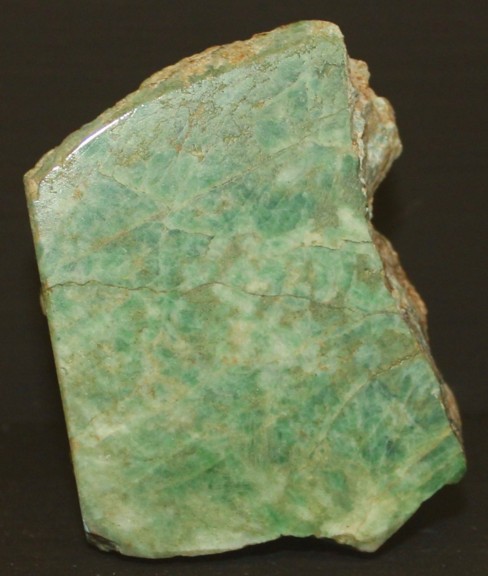|
.
Jadeite
Mineral Facts:
Chemical
Formula: NaAlSi2O6
Sodium
aluminum metasilicate. May contain minor amounts of iron, chromium and
other elements which serve as coloring agents. Forms in part the material
known as jade and highly prized as an ornamental material.
Colors:
White, Yellow, Various Green
tones,
Blue, Mauve violet, Grayish white.
The more
brilliant green stones are due to the presence of areas containing chromium
as a coloring agent.
Hardness:
6
to 7
Density:
3.24 to 3.43
Cleavage:
Good on
(110).
Crystallography: Monoclinic
Commonly Jadeite occurs in fibrous, flaky and dense, finely granular masses
showing a
compact structure.
Prismatic crystals are rare.
Luster:.
Glassy luster, inclining to pearly on cleavage surfaces.
Optics:
(Refractive Index):
= 1.67
Most specimens are
slightly translucent to
opaque. |

Jadeite,
Republic of Myanmar (Burma) |
|
Composition, Structure and
Associated Minerals:
Jadeite is a silicate of sodium and aluminium, with sometimes a little iron.
Like nephrite, it does not show crystalline form, being found in the form of
tough, compact masses of interlacing
crystalline fibers. Jadeite is formed in metamorphic rocks under high pressure and
relatively low temperature conditions.
In all of the well documented deposits, jadeitite
appears to have formed in tectonic subduction zone fluids in association with serpentinite.
Jadeitite is resistant to weathering, so boulders of jadeitite released
from the serpentine-rich environments in which they formed are found in a
variety of alluvial gravel environments. Jadeite differs from spodumene in having sodium in place of
lithium.
Identification
and Diagnostics
Before the
blowpipe jadeite fuses easily to a transparent,
bubbly glass. This is important as it's easy fusibility as compared
with
nephrite is a useful and distinctive test.
It is
insoluble in ordinary acids. After fusion, however, it is easily decomposed by
HC1 and sometimes by Na2CO3 . At high temperatures (225--235) it is also
decomposed by water.
Gives a strong yellow flame coloration due to
sodium.
Occurrence,
Localities and Origins:
The
mineral is of great ethnological interest because so many ornaments were
made of a rock composed mainly of jadeite by the ancient
inhabitants of China, Mexico, South America and elsewhere. "Jade" ornaments,
however, are not all made of jadeite, but in all instances their
material resembles this mineral in color, structure and density. Many of
them are made of fibrous amphiboles, some of which correspond to
jadeite in composition. Most Jadeite jade, like nephrite jade is a mixture
of minerals, and technically a rock.
|

Jadeite, Motagua Valley, Guatemala |
|
|
It has long been known that Mesoamerican cultures produced jadeite objects,
but for centuries the geologic source was unknown. In the latter part of the
20th century an in place jadeite deposit was found at the Motagua Valley in
Guatemala. This jade, sometimes called "Olmec blue" is characterized by
its deep blue-green, translucent hue with white flecking. The Motagua Valley is only being
minimally exploited by native Guatemalans. Other Jadeite items were also
found in Costa
Rica and the source of these may be unknown.
The most important occurrence of jadeite is
that near Tawmaw in the Myitkyina district of Upper Myanmar (Burma), where the mineral
occurs as a constituent of a dyke rock intrusive in serpentine, and is
regarded as an alteration product of the sodium aluminium silicates, albite
and nepheline. The alteration is attributed to thermodynamic metamorphism
during subduction.
Jadeite quarrying is an important industry in Upper Myanmar (Burma); the stone is
quarried from the dyke as well as obtained in the form of boulders from the
bed of the neighboring Uru river, and much of it is sent to China, where it
is highly valued as an ornamental stone.
Another occurrence of jadeite is that near Gulbashen, in the Karakash
valley, in the People's Republic of China, where the mineral is found associated with
nephrite. Jadeite is often confused with nephrite, but is readily
distinguished from the latter by its easier fusibility, its higher specific
gravity, and its rather greater hardness. Currently, the best known sources of gem quality
jadeite In North America are
California,
British Columbia,
Alaska,
and more recently
Guatemala, Central America;
other localities of jadeite Around the world include
Kazakhstan,
Russia,
Myanmar (Burma),
New
Zealand, Italy and
China.
.Return
to the
Mineral Collectors Information Page
|


